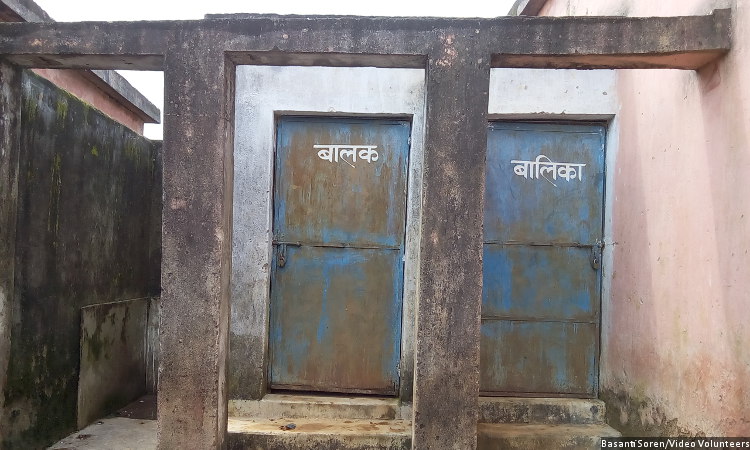Despite 2015 Claim By PM, 24% Schools In 9 States Still Lack Toilets For Girls

As many as 24% schools across nine states (Andhra Pradesh, Bihar, Chhattisgarh, Jharkhand, Karnataka, Madhya Pradesh, Odisha, Telangana and Uttar Pradesh) lack separate toilets for girls and boys, according to a 2016 study that covered over 450 schools by WaterAid India, an international nonprofit.
There is a toilet for every 66 girls and a toilet for every 76 boys--below the government norm of one for every 40, the report said. The government launched the Swachh Vidyalaya Abhiyaan (Clean School Programme) in 2014 to ensure separate functional toilets for girls and boys in every government school.
On August 15, 2015, Prime Minister Narendra Modi declared that separate toilets had been constructed for girls in all Indian schools, but the claim failed scrutiny during a random nationwide check by Factchecker.in in September 2015. Data from the new WaterAid study confirm this finding, as do ground reports from our partner Video Volunteers, a global initiative that empowers disadvantaged communities with story and data-gathering skills, and trains them to use video as a tool to mobilise for change.
While 95% schools had functional toilets, separate toilets for girls and boys were found in only 76% of the schools assessed, the WaterAid report said.
“417,796 toilets were constructed in 261,400 elementary and secondary government schools in a period of one year from August 15, 2014 to August 15, 2015,” said this reply by the minister for human resource development to the Lok Sabha (parliament’s lower house) in July 2016.
None of the states assessed complied with the 100% requirement: Chhattisgarh had 90% schools with separate toilets for boys and girls, followed by Jharkhand (89%) and Uttar Pradesh (83%), while schools in Odisha (61%) and Karnataka (70%) had the least number of schools with separate toilets.
Source: WaterAid India
The lack of facilities is worrying for girls since “the need for privacy, and the generally unusable state of sanitation facilities results in girls controlling their bladders for as long as 13 hours a day”, said this 2016 report Dignity For Her by Dasra, a philanthropic foundation. “The long-lasting repercussions are on their overall as well as reproductive and sexual health.”
Even if their schools had toilets, 15% of students interviewed by WaterAid said they never used the toilets, mainly because they lacked water, were locked or were dirty.
While 76% students claimed to use the latrines to defecate, 20% said they would always defecate in the open, in fields or in the school ground.
14% schools lack safe drinkable water; Chhattisgarh, Bihar worst states
Water for drinking, washing hands and for toilets was accessible through the vast majority of schools surveyed by WaterAid.
While almost 9% schools did not have access to drinking water, 14% did not have safe drinking water, suggesting that not all drinking water was potable.
Uttar Pradesh (94%) and Madhya Pradesh (93%) had the largest proportion of schools with safe drinking water, while Bihar (57%) and Chhattisgarh (50%) were the worst performing states of the nine surveyed.
Source: WaterAid India
Meghalaya (37%) has the largest proportion of schools without drinking water facility, followed by Nagaland (24%), Arunachal Pradesh (22%), Manipur (13%) and Assam (11%), according to government data.
While 10% schools surveyed by WaterAid experienced shortages of water during summer, the issue could not be addressed by storing water, since almost half the schools did not have storage facilties.
Of those provided with storage facilities--tanks were the most common--14% reported their stored water “improperly covered or not covered at all”, leaving them open to possible contamination.
Without menstrual management facilities, 23% of girls drop out
As many as 80% of the schools did not have any facility for girls to manage menses: They did not have a place to hang their menstrual absorbent, facilities to wash the absorbent or disposal mechanisms for menstrual waste, according to the WaterAid study. This led to 55% girls throwing their used absorbent outside school premises.
As many as 70% girls in India do not know what menstruation is before they get their first period, according to the 2016 Dignity for Her report, despite a commitment by the government to spread awareness of menstrual hygiene among adolescent girls.
Only 41% teachers teach menstrual hygiene, according to WaterAid.
Only 33% girls attend schools during menstrual periods, resulting in a 20% absence during the school year due to menstruation; the second biggest reason--after household work--why they miss school, according to the 2016 Dignity for Her report.
As many as 23% of girls are deemed to have dropped out from school on reaching puberty because of the lack of menstrual-management facilities, the report said.
Correction: We earlier said "On August 15, 2014, Prime Minister Narendra Modi declared that separate toilets had been constructed for girls in all Indian schools". The declaration was made in the prime minister's Independence Day speech in 2015. The story and the headline have been corrected accordingly. We regret the error.
(Grocchetti is a multimedia journalist and has a BA degree from Napier University, Edinburgh. Video stories by Video Volunteers, a global initiative that empowers disadvantaged communities with story and data-gathering skills, and trains them to use video as a tool to mobilise for change.)


